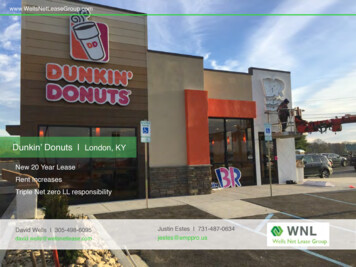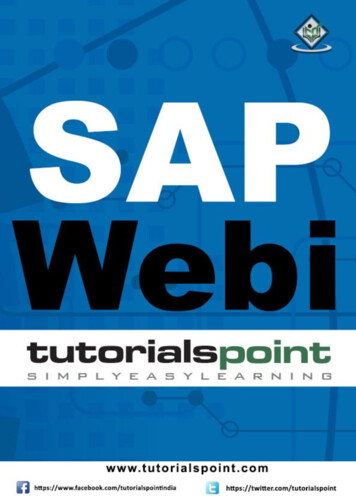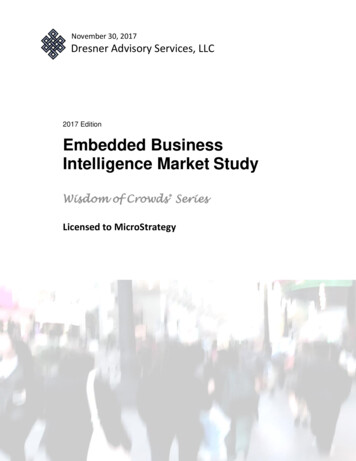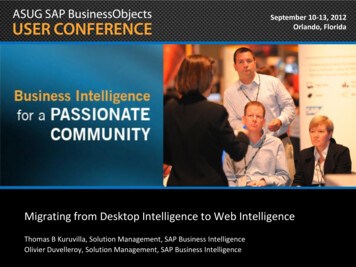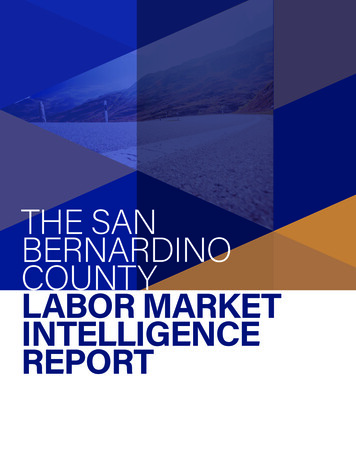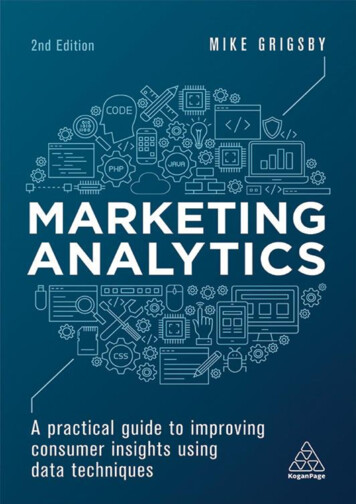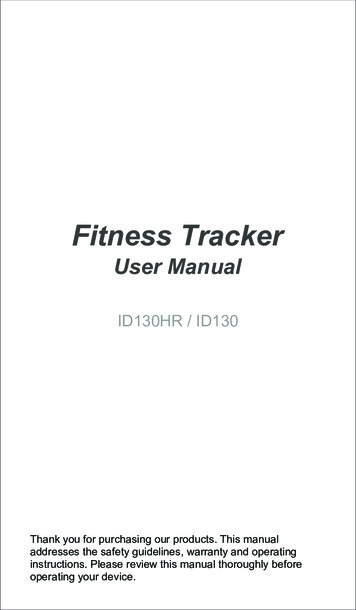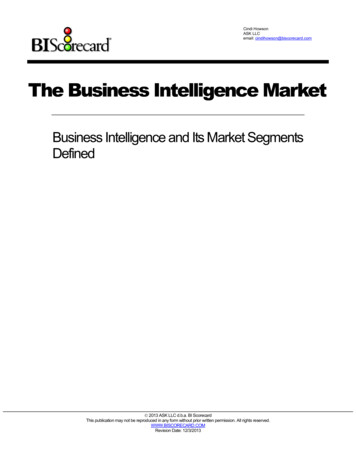
Transcription
Cindi HowsonASK LLCemail: cindihowson@biscorecard.comThe Business Intelligence MarketBusiness Intelligence and Its Market SegmentsDefined 2013 ASK LLC d.b.a. BI ScorecardThis publication may not be reproduced in any form without prior written permission. All rights reserved.WWW.BISCORECARD.COMRevision Date: 12/3/2013
PAGE 1 OF 11The Business Intelligence MarketBusiness Intelligence and Its Market Segments DefinedBusiness intelligence allows people at all levels of an organization to access, interact with,and analyze data to manage the business, improve performance, discover opportunities,and operate efficiently. It is not a technology you implement and then put in maintenancemode; it is an approach and set of technologies that are continuously evolving andadapting as the business climate changes, users discover new opportunities to leverageinformation, and the industry innovates.Companies of all sizes and industries leverage business intelligence to identify cost savingopportunities and to improve services and products as a way of beating the competition.When you implement business intelligence tools, the focus of the project is not to finish,but rather, to deliver a certain amount of value and functionality within a predefined period.There was a time when the BI tools market was synonymous with query and reporting.Then OLAP arrived on the scene in the mid 1990s and analytic applications in the late1990s (they’ve both been around longer but called something different). Dashboards, inmemory analytics, and advanced visualization and discovery seem to be the latest buzz.Meanwhile, a number of related technologies such as data warehousing and enterpriseinformation management are now also referred to as BI technologies. Such technologiescertainly provide the “plumbing” for business intelligence, but sometimes these semanticsonly confuse the industry as to what technologies we are discussing. Thus, the front-endcomponents that business users interact with are now generally referred to as BI tools orBI platforms; usually a platform includes multiple tools and modules. If you areevaluating vendor products, it is important to understand which functionality you arelooking for and whether or not the vendor has a solution in that space.The following are segments within the BI market. If you analyze BI market shares, keep inmind that analysts will isolate and/or combine these segments differently. For each segment, the tables list BI vendors currently covered by BI Scorecard and theirrespective solutions. The tables are not representative of which vendors are leaders in anyone segment, but rather, allow you to compare vendor offerings across the segments.We recommend you use this report to assess the breadth of a vendor’s product line andas a way of ensuring you are comparing like-for-like products. Use this report toappropriately position products by use case and optimal user profile. For a review of theproducts’ strengths and weaknesses, refer to the BI Scorecard Strategic and ProductSummary.
PAGE 2 OF 11Query and ReportingQuery and reporting is the process of querying a data source, then formatting it to create areport, either a production-style report, such as an invoice, or a management-style report.These two market segments go by many names, creating a fair amount of customerconfusion.The needs within production reporting are often different than the needs within businessquery and reporting. Yet sometimes, the needs blur and the lines cross and just as youcan use a hammer to get a screw into the wall, you can use a production reporting tool formanagement reporting. The converse, however, is not true; rarely can you use a businessquery and reporting tool to develop production reports. A business query tool may notsupport pixel-perfect layouts, normalized data sources, or programmability that ITdevelopers demand.With business query and reporting, the data source is more often a data warehouse ordata mart (though not always). Whereas IT develops production reports, power users andcasual business users develop their own reports with business query tools. The followingtable compares some additional characteristics that help distinguish production-stylereports from business-style reports. These characteristics are by no means absolutes.Neither of these segments is precise. Production reports are not necessarily pixel-perfect,although some are. Reports generated with business query tools can be used individually,departmentally or enterprise-wide.CharacteristicProductionBusiness Query & ReportingPrimary authorIT DeveloperPower user or business userPurposeMonitor or complete an operational taskDecision-making and analysisReport deliveryPaper or e-bill, embedded in anapplicationPortal, spreadsheet, emailPrint qualityPixel-perfectPresentation qualityUser base10s of 1000s100s or 1000sData sourceOLTP – real timeData warehouse or mart, occasionallyOLTPLevel of data detailGranularAggregatedScopeOperationalTactical, strategicUsageOften embedded within an OLTPapplicationBI as a separate applicationThe characteristics and authors of these two types of queries and reports are distinct. Yetmust they be distinct tools? Vendors have been trying to converge these segements foryears, but even when a vendor serves both segments, often it is via distinct interfaces withvarying degrees of shared components. Cognos was the first vendor to launch oneproduct that serves both production style reporting and business query and reporting:ReportNet, launched in September 2003. In reality, though, Cognos 8 has distinct studiosfor the different segments (Report Studio and Query Studio), as does Cognos 10 (ReportStudio and Business Insight). MicroStrategy launched Report Services in December 2003for highly formatted reports. While it can create pixel perfect reporting, rarely isMicroStrategy deployed against an On-line Transaction Processing (OLTP) system.Crystal Reports is one of those products whose sweet spot is production reporting, yet itcan also be used for business-style reports that IT develops. Microsoft Reporting Servicesalso has two interfaces – Report Designer within Visual Studio and Report Builder. The
PAGE 3 OF 11report output and definition created for either is the same, but each interface servesdistinct authoring requirements for sophisticated versus casual users.Production ReportingProduction reporting typically involves querying an OLTP database, then formatting it tocreate a document, perhaps an invoice, a bank statement, a check, or a list of openorders. When the reporting is not against the transaction system, it may be against anoperational data store or detailed data within a data warehouse. Often, production stylereporting is done via custom programming as the information needs and report layout mayrarely change. One of the challenges with vendors who focus exclusively on productionreporting is that users may never know they are using a BI tool; the product is soembedded within the OLTP application that there is little brand awareness for the BI tool.Other key players in this market segment include Actuate, LogiXML, and inetSoft.Production reporting tools are more likely to have a desktop authoring interface but notalways.VendorSAPBusinessObjectsIBM CognosMicroStrategyMicrosoftInformation BuildersProductCrystal Reports(acquired in 2003 from Crystal Decisions)SAP Business Explorer (BEx) Report Designer will be replaced byCrystal ReportsCognos Report StudioReport Services(launched in 2003)Reporting Services Report Designer interface within Visual Studio(launched in 2004)Web Focus Developer StudioWeb e Publisher is the lead productSASNA, although you can write SAS code to create a highly formattedreportBIRT Designer ProDesktopReport DesignerDesktopJasper r, Layout modeEitherWeb
PAGE 4 OF 11Business Query and ReportingBusiness query and reporting tools are intended for users who want to author their ownreports. These users are less concerned with the precise layout (since they aren’t trying togenerate an invoice) but do want charts and tables quickly and intuitively. The formattingcapabilities vary dramatically in this segment. Tools in this segment are also referred to as“ad hoc” query tools, but often the reports created by business users become standardreports and are not exclusively used for ad hoc business questions. Nowadays the Web ispredominantly the authoring environment.VendorSAP BusinessObjectsProductWeb Intelligence for Web-based authoringMicrosoftCognos 10.2 Workspace for viewing and Workspace Advanced for greaterauthoring (renamed from Business Insight)Desktop for desktop authoringWeb for Web-based authoringReport Builder Smart ClientInformation BuildersInfoAssistOracleOracle Answers (from Siebel Analytics acquisition), a Web-based interface withinOracle BI Enterprise EditionWeb Report Studio as part of EBI platform, or SAS Visual Analytics DesignerIBM tBIRT StudioWeb Ad-Hoc Query Tool (WAQR)Ad hoc ReportingDesigner
PAGE 5 OF 11On Line Analytical Processing (OLAP)OLAP and its architectures are defined in more depth in the OLAP criteria. Many BIvendors provide both query and reporting solutions as well as an OLAP tool. Some BIvendors provide it via one integrated product; others offer separate products. In itsbroadest definition, OLAP provides interactive, multidimensional analysis with differentdimensions and different levels of detail. In evaluating OLAP tools, it’s helpful to distinguishbetween platform issues and user interface issues. There are a few specialty vendors inthis segment such as arcplan, Panorama Novaview, Strategy Companion, and ParisTechnologies PowerOLAP that provide OLAP viewers to integrate with third-party OLAPplatforms. With the rise of in-memory computing and analytic databases, the need for aseparate multi-dimensional database can be challenged.VendorSAP BusinessObjectsIBM CognosOLAP PlatformWeb IntelligenceSAP NetWeaver BW(InfoCubes)PowerPlay ServerTM1 (acquired from Applix in2007)ArchitectureDOLAP/ROLAPSAP HANA for in-memoryOLAPMOLAP PowerCubes andTM1, or ROLAP in Cognos 8Dynamic Cubes in Cognos10.2User InterfacesWeb IntelligenceVoyager renamed AnalysisEdition for OLAP in 4.0Cognos 10 WorkspaceAnalysis Studio supported asmigration strategy.Executive Viewer for TM1also used in Cognos ExpressDesktopWebMicroStrategyIntelligence ServerOLAP Services provides OLAPcaching and in-memoryROLAPMicrosoftAnalysis ServicesMOLAP, HOLAP, ROLAPSQL Server 2012 In-MemoryTabular Data ModelsInformationBuildersOEM columnar database,Hyperstage (2012)Excel PowerPivotPerformance Point , Analysiscapabilities based onProClarityInfoAssistOLAP Option is MOLAPstored in the RDBMS but thatcan be queried with SQLOLAP Option supports anySQL-based toolsOBBI EE AnswersOracleOLAP Option for the databaseHyperion EssbaseExalyticsOBI EE is ROLAPHyperion Essbase is primarilyMOLAP but supports HOLAPExalytics for In-memorySASActuatePentahoJaspersoftBirstOLAP ServerMOLAP/HOLAPWeb Report Studio & WebOLAP ViewerBIRT Data AnalyzerMondrianROLAPAnalyzerJaspersoft OLAP (Mondrian)ROLAPJaspersoft Ad-Hoc AnalysisUIDesigner or DashboardsROLAP
PAGE 6 OF 11DashboardsAs web-based business query and OLAP tools have reached a reasonable level ofmaturity and adoption, dashboards have fast become the next major area of innovationand adoption. There are a number of niche dashboard vendors and new products from BIsuite vendors.According to industry visualization expert Stephen Few, President of Perceptual Edge, “adashboard is a visual form of information display, which is used to monitor what’s currentlygoing on in the business at a glance.” Any tool that can display multiple objects frommultiple data sources, then, can correctly be referred to as a dashboard. For somevendors, a report can correctly be referred to as a dashboard, and for others, a portal mayprovide the dashboard capabilities. Better dashboard products, though, go well beyondthese two basic criteria.Ideally, users want to assemble their own dashboards with the information relevant to theirjob. Not all tools allow this, though, and may force IT to build dashboards in advance. ForBI Scorecard to consider something a dashboard, it must enable information frommultiple data sources, be highly visual, have a way of highlighting exceptions (trafficlighting or alerts), and have a degree of interactivity.The following table lists dashboard-specific products. Keep in mind, however, that youmay be able to use functionality within the core BI tool to build a basic dashboard. As well,specialty vendors such as QlikTech, Dundas, and iDashboards provide dashboardcapabilities.PlatformVendorSAP BusinessObjectsIBM cleSASActuatePentahoJaspersoftBirstProductXcelsius renamed Dashboards in 4.0Design Studio replaces Web Application Designer (for BW & HANA)WorkspaceDynamic Enterprise Dashboards (released March 2007)Dashboard Designer, a rich client product that is part of PerformancePoint builds thedashboards that are deployed via portals in SharePoint. PowerView and PowerPivotsupport dashboards as wellDeveloper Studio and Portal in v8Oracle BI Interactive DashboardsOracle Endeca Information Discovery for exploratory dashboards, unstructured contentSAS Visual Analytics DesignerBIRT QlikViewiDashboardsDundas
PAGE 7 OF 11Performance ManagementPerformance management applications include budgeting and planning and financialconsolidation. On the customer buying side, the degree to which customers buy BI andperformance management from the same vendor depends not only on productcapabilities, but also on the degree to which the CFO and CIO co-operate. It’s important tonote that budgeting and planning does not apply to financial metrics only, but also toworkforce, capital, and so on.SAP BusinessObjectsVendorPlanning / Financial Reporting / ConsolidationLead product for planning: SAP Business Planning and Consolidation (acquired by SAPfrom OutlookSoft in 2007)IBM CognosFor consolidations: Business Objects Financial Consolidations (acquired from Cartesis in2007) and SAP Business Planning and Consolidation (from OutlookSoft)Controller, ANANAOracleHyperion Financial Manager, Hyperion PlanningSASSAS Financial ManagementBirstNA
PAGE 8 OF 11ScorecardsWhereas dashboards present multiple numbers in different ways, a scorecard focuses ona given metric and compares it to target. In analyzing performance versus the target, ascorecard may provide a root cause analysis and track accountability. Scorecard productsare often certified by the Balanced Scorecard Collaborative. Scorecards contain agreedupon metrics or key performance indicators aligned with the company’s strategy. Thesekinds of strategic scorecards are sometimes included as part of a total performancemanagement solution and certain industry analysts will count scorecards as part of theperformance management industry. Key performance indicators may also be an optionwithin a dashboard product. While KPIs within a dashboard may provide a snapshot of aKPI, within strategic scorecards, the KPIs are at a higher level, allowing you to assignaccountability and track root causes via strategy maps.VendorSAP BusinessObjectsIBM ductSAP Strategy Management (acquired from Pilot Software in 2007)Metrics Studio replaced by TM1 Scorecarding 2013NAPerformancePoint, monitoring capabilities (based on earlier Business ScorecardManager)Performance Management FrameworkOracleOracle Scorecard and Strategy Management (new in 11g)SASStrategic Performance ManagementActuateBirstBIRT 360NA
PAGE 9 OF 11Predictive Analytics and Data MiningData mining is a particular kind of analysis that reveals patterns in data using variousalgorithms. Whereas standard query and reporting tools require you to ask a specificquestion, a data mining tool will help users discover relationships or show patterns in amore exploratory fashion. Predictive analytics allow users to create a model, test themodel based on actual data, and then project future results. Data mining is used inpredictive analysis, fraud detection, customer segmentation, and market basket analysis.Although data mining is one segment of the BI market, it continues to be an applicationreserved for specialist users with SAS, SPSS, Angoss, and open source R leading themarket. Each vendor has a different approach in where the analytics should be done. Inthe past, statisticians have largely extracted data from source systems and datawarehouses to perform analyses outside of the BI environment. In 2008, SAS andTeradata entered into a joint technology agreement where more of the processing ispushed to the database.In an effort to make BI more actionable, some BI vendors are incorporating data miningand predictive analytics into their BI suite. This does not mean that predictive analytics willbecome “mainstream”, but rather, that the results of such analysis can be readilyincorporated into every day reports and decision-making.VendorSAP BusinessObjectsIBM CognosMicroStrategyMicrosoftInformation BuildersProductPredictive Analysis released in Q1 2013, KXEN acquired in Q3 2013. HANA haspredictive algorithms.SPSS acquired in 2009Data Mining Services (clustering, association, linear regression embeddedwithin. MicroStrategy 8); one of the few that can access predictive models usingPMML created in 3rd party data mining software.SQL Server, decision trees and clustering. Data Mining add-in in Excel leverageAnalysis ServicesPredictive Analysis (released Q3 2009) based on ROracleData Mining option for the database or for Essbase. Real Time Decisioningcombines rules and statistical.SASEnterprise Miner, plus stored processes exposed to Web Report Studio. RapidPredictive Modeler (RPM) became part of the SAS Add-In for Microsoft Office forusers to create models in Excel August 2010.WekaPentahoTIBCO SpotfireTableauStatistics Services, S , with R run-time engine in Spotfire 5 (Q4 2012)R integration to be added in Q4 2013
PAGE 10 OF 11Visual Data DiscoveryAdvanced visualizations are increasingly appearing in dashboard products from BIvendors, but for the most part, better capabilities exist in specialty products. Visual DataDiscovery tools speed the time to insight through the use of visualizations, best practicesin visual perception, and easy exploration. Such tools support business agility and selfservice BI through a variety of innovations that may include in-memory processing andmashing of multiple data sources.The difference in these tools versus most dashboard products is usually in:1. the degree of sophisticated analysis and visualization types such as smallmultiples, spark lines, heat maps, histograms, waterfall charts, bullet graphs, andso on.2. adherence to best practices according to the visualization community3. degree of out-of-the box, automatic interactivity and visual exploration versus firstrendering data in tabular data display and then creating a chart4. ease at which an individual user can explore data, connect to new data sources,and mash data from multiple sources, without the support of IT in getting startedProductVendorSAP BusinessObjectsExplorer has some light weight visual discovery capabilities. VisualIntelligence released in May 2012. Rebranded Lumira May 2013Web orDesktopAuthoringExplorer WebLumira DesktopCognos Insight released February 2012. Project Neo in beta Q1 1014for NLP and discoveryVisual Insight new interface in Q1 2011.DesktopSharePoint PowerView released in 2012, added to Excel 2013Desktop, ExcelVisual Discovery (OEM’d from Advizor Solutions)DesktopExalytics with OBI EE smart visualizations. Oracle Endeca is more fortextual dashboards.JMP
reporting is that users may never know they are using a BI tool; the product is so embedded within the OLTP application that there is little brand awareness for the BI tool. Other key players in this market segmen and inetSoft. t include Actuate, LogiXML, Production reporting tools are more
